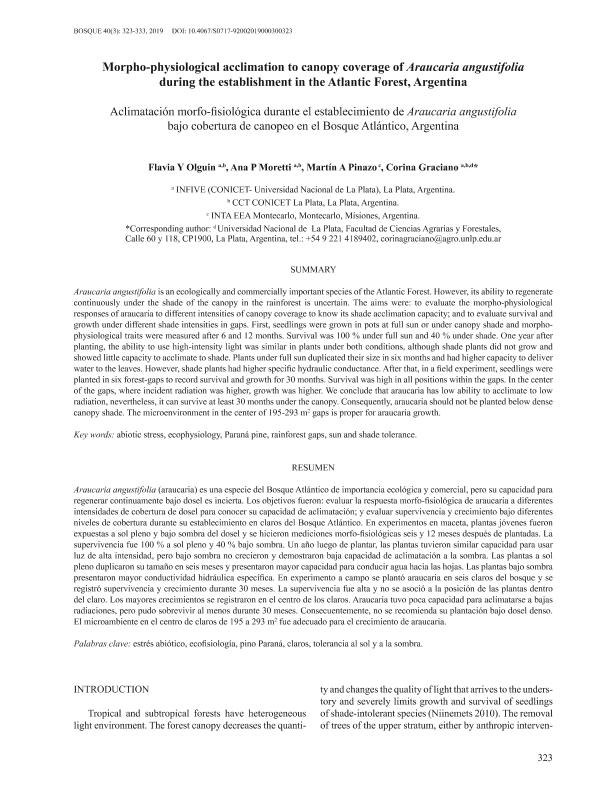Mostrar el registro sencillo del ítem
dc.contributor.author
Olguin, Flavia Yesica

dc.contributor.author
Moretti, Ana Paula

dc.contributor.author
Pinazo, Martín Alcides

dc.contributor.author
Graciano, Corina

dc.date.available
2021-01-12T19:41:44Z
dc.date.issued
2019-12
dc.identifier.citation
Olguin, Flavia Yesica; Moretti, Ana Paula; Pinazo, Martín Alcides; Graciano, Corina; Morpho-physiological acclimation to canopy coverage of Araucaria angustifoliaduring the establishment in the Atlantic Forest, Argentina; Universidad Austral de Chile; Bosque (Valdivia); 40; 3; 12-2019; 323-333
dc.identifier.issn
0304-8799
dc.identifier.uri
http://hdl.handle.net/11336/122539
dc.description.abstract
Araucaria angustifolia is an ecologically and commercially important species of the Atlantic Forest. However, its ability to regenerate continuously under the shade of the canopy in the rainforest is uncertain. The aims were: to evaluate the morpho-physiological responses of araucaria to different intensities of canopy coverage to know its shade acclimation capacity; and to evaluate survival and growth under different shade intensities in gaps. First, seedlings were grown in pots at full sun or under canopy shade and morpho-physiological traits were measured after 6 and 12 months. Survival was 100 % under full sun and 40 % under shade. One year after planting, the ability to use high-intensity light was similar in plants under both conditions, although shade plants did not grow and showed little capacity to acclimate to shade. Plants under full sun duplicated their size in six months and had higher capacity to deliver water to the leaves. However, shade plants had higher specific hydraulic conductance. After that, in a field experiment, seedlings were planted in six forest-gaps to record survival and growth for 30 months. Survival was high in all positions within the gaps. In the center of the gaps, where incident radiation was higher, growth was higher. We conclude that araucaria has low ability to acclimate to low radiation, nevertheless, it can survive at least 30 months under the canopy. Consequently, araucaria should not be planted below dense canopy shade. The microenvironment in the center of 195-293 m2 gaps is proper for araucaria growth.
dc.description.abstract
Araucaria angustifolia (araucaria) es una especie del Bosque Atlántico de importancia ecológica y comercial, pero su capacidad para regenerar continuamente bajo dosel es incierta. Los objetivos fueron: evaluar la respuesta morfo-fisiológica de araucaria a diferentes intensidades de cobertura de dosel para conocer su capacidad de aclimatación; y evaluar supervivencia y crecimiento bajo diferentes niveles de cobertura durante su establecimiento en claros del Bosque Atlántico. En experimentos en maceta, plantas jóvenes fueron expuestas a sol pleno y bajo sombra del dosel y se hicieron mediciones morfo-fisiológicas seis y 12 meses después de plantadas. La supervivencia fue 100 % a sol pleno y 40 % bajo sombra. Un año luego de plantar, las plantas tuvieron similar capacidad para usar luz de alta intensidad, pero bajo sombra no crecieron y demostraron baja capacidad de aclimatación a la sombra. Las plantas a sol pleno duplicaron su tamaño en seis meses y presentaron mayor capacidad para conducir agua hacia las hojas. Las plantas bajo sombra presentaron mayor conductividad hidráulica específica. En experimento a campo se plantó araucaria en seis claros del bosque y se registró supervivencia y crecimiento durante 30 meses. La supervivencia fue alta y no se asoció a la posición de las plantas dentro del claro. Los mayores crecimientos se registraron en el centro de los claros. Araucaria tuvo poca capacidad para aclimatarse a bajas radiaciones, pero pudo sobrevivir al menos durante 30 meses. Consecuentemente, no se recomienda su plantación bajo dosel denso. El microambiente en el centro de claros de 195 a 293 m2 fue adecuado para el crecimiento de araucaria.
dc.format
application/pdf
dc.language.iso
eng
dc.publisher
Universidad Austral de Chile

dc.rights
info:eu-repo/semantics/openAccess
dc.rights.uri
https://creativecommons.org/licenses/by-nc/2.5/ar/
dc.subject
ABIOTIC STRESS
dc.subject
ECOPHYSIOLOGY
dc.subject
PARANÁ PINE
dc.subject
RAINFOREST GAPS
dc.subject
SUN AND SHADE TOLERANCE
dc.subject.classification
Silvicultura

dc.subject.classification
Agricultura, Silvicultura y Pesca

dc.subject.classification
CIENCIAS AGRÍCOLAS

dc.title
Morpho-physiological acclimation to canopy coverage of Araucaria angustifoliaduring the establishment in the Atlantic Forest, Argentina
dc.title
Aclimatación morfo-fisiológica durante el establecimiento de Araucaria angustifolia bajo cobertura de canopeo en el Bosque Atlántico, Argentina
dc.type
info:eu-repo/semantics/article
dc.type
info:ar-repo/semantics/artículo
dc.type
info:eu-repo/semantics/publishedVersion
dc.date.updated
2020-12-09T20:16:14Z
dc.identifier.eissn
0717-9200
dc.journal.volume
40
dc.journal.number
3
dc.journal.pagination
323-333
dc.journal.pais
Chile

dc.journal.ciudad
Valdivia
dc.description.fil
Fil: Olguin, Flavia Yesica. Consejo Nacional de Investigaciones Científicas y Técnicas. Centro Científico Tecnológico Conicet - La Plata; Argentina. Consejo Nacional de Investigaciones Científicas y Técnicas. Centro Científico Tecnológico Conicet - La Plata. Instituto de Fisiología Vegetal. Universidad Nacional de La Plata. Facultad de Ciencias Naturales y Museo. Instituto de Fisiología Vegetal; Argentina
dc.description.fil
Fil: Moretti, Ana Paula. Consejo Nacional de Investigaciones Científicas y Técnicas. Centro Científico Tecnológico Conicet - La Plata. Instituto de Fisiología Vegetal. Universidad Nacional de La Plata. Facultad de Ciencias Naturales y Museo. Instituto de Fisiología Vegetal; Argentina. Consejo Nacional de Investigaciones Científicas y Técnicas. Centro Científico Tecnológico Conicet - La Plata; Argentina
dc.description.fil
Fil: Pinazo, Martín Alcides. Instituto Nacional de Tecnología Agropecuaria. Centro Regional Misiones. Estación Experimental Agropecuaria Montecarlo; Argentina
dc.description.fil
Fil: Graciano, Corina. Consejo Nacional de Investigaciones Científicas y Técnicas. Centro Científico Tecnológico Conicet - La Plata. Instituto de Fisiología Vegetal. Universidad Nacional de La Plata. Facultad de Ciencias Naturales y Museo. Instituto de Fisiología Vegetal; Argentina. Consejo Nacional de Investigaciones Científicas y Técnicas. Centro Científico Tecnológico Conicet - La Plata; Argentina. Universidad Nacional de La Plata. Facultad de Ciencias Agrarias y Forestales; Argentina
dc.journal.title
Bosque (Valdivia)

dc.relation.alternativeid
info:eu-repo/semantics/altIdentifier/url/http://revistas.uach.cl/index.php/bosque/issue/view/488
dc.relation.alternativeid
info:eu-repo/semantics/altIdentifier/doi/http://dx.doi.org/10.4067/S0717-92002019000300323
Archivos asociados
